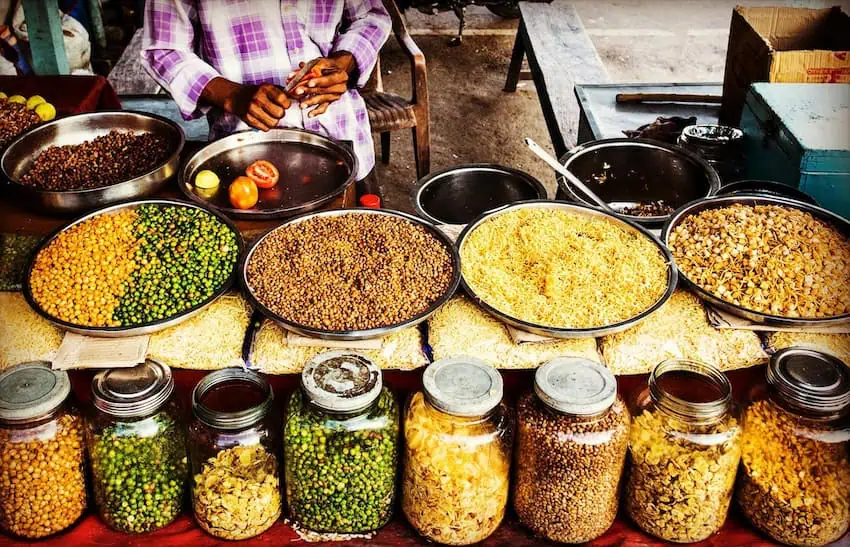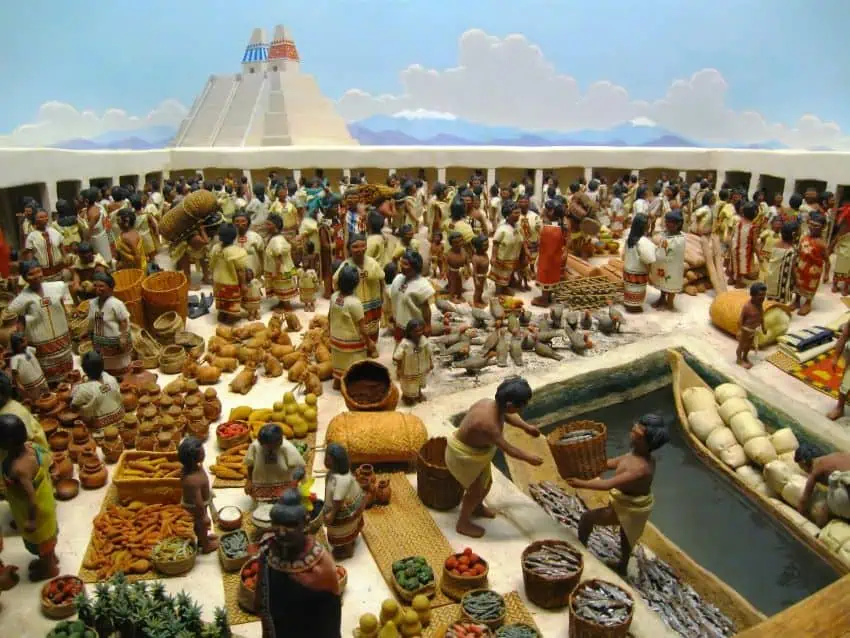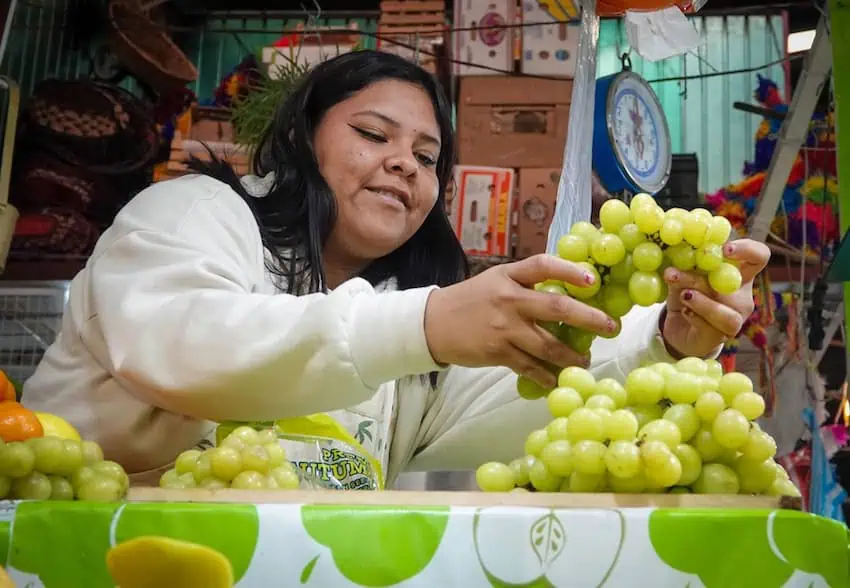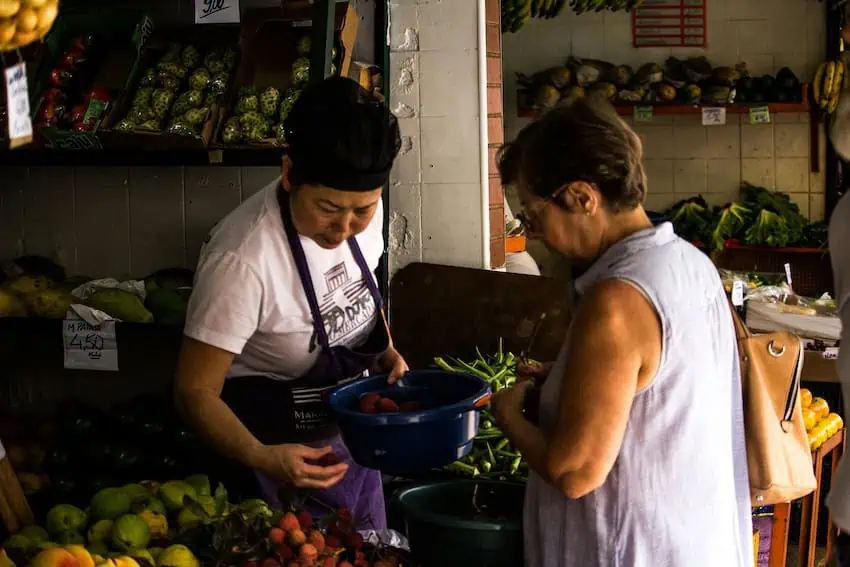After teaching my 7 a.m. yoga class, an important part of my daily routine is heading straight to the Mercado 24 de Agosto, my local market. I usually take a 15-minute walk from the studio, located in the residential Colonia Del Valle, through tree-lined streets, enjoying the gentle morning breeze. I look forward to this every day, especially on Wednesdays, when I go to buy groceries.
Why would I bother buying from a local market if multinational chains like Walmart or Costco are closer, you might ask? I could even use online supermarket services to have my groceries delivered to my door. My father often questions my shopping habits, curious as to why I choose to shop this way. There’s no straight answer. The main reason is that there is a unique joy to buying your groceries at a traditional Mexican market. It probably comes from embodying a centuries-old, living Mesoamerican tradition.

Embodying an ancient living tradition
Local markets in Mexico come from the tradition of the pre-Hispanic tianguis, a Mexican Spanish word adapted from the Nahuatl word “tianquiztli,” meaning “market.” Originally, Mesoamerican tianguis followed the barter exchange scheme. In Tenochtitlan — present-day Mexico City — for example, the Mexica and other peoples who came to trade with them used currencies including cacao beans, copper axe heads and cotton capes.
Mexican markets have always been crowded places. Hernán Cortés, the Spanish conquistador, could not help but marvel at the greatness of the Tlatelolco market, Mesoamerica’s largest. He and his party were “particularly astounded at the incalculable number of people gathered, between 40,000 and 60,000,” researcher Pascale Villegas wrote for the Institute of Philological Research of the National Autonomous University of Mexico (UNAM).
Centuries later, under the influence of European markets brought by the Spanish, tianguis and mercados have become very different establishments. The former are usually set in the street on specific days of the week and have temporary stalls; the latter are open practically every day, and are permanent buildings with commercial premises inside of them. There are also many more tianguis in Mexico City as compared to markets: 1367 tianguis to 353 public markets, according to the capital’s Economic Development Ministry (Sedeco).
In a nutshell, tianguis are more like street markets, whereas mercados are local stores. In many cases, both mercados and tianguis are dedicated to the sale of one specific type of item. The Mercado de la Lagunilla, for example, specializes in selling antiques, whereas the Mercado de Sonora is world-famous for its witchcraft items. You may also have encountered vintage clothing tianguis every now and then in Roma Norte, or tianguis de fruta with the freshest fruit in the neighborhood. Depending on the area and specialty of merchants, you can find everything from textiles to cleaning products and fresh veggies.

Shopping at a Mexican mercado is a cultural experience
Merchants screaming every product in stock at the top of their lungs, workers rushing through the aisles with their classic diablito hand trucks and the scent of raw meat and champurrado. Everything seems to crowd your senses at once, while being watched over by the patron saint of the market in question.
Geographer Adrián Hernández Cordero strikes a poignant note when he describes mercados as a new kind of museum “where, unlike traditional venues, tourists can witness and participate in the enactment of everyday city life.” Not only that. Unlike a typical museum, Hernández points out, both mercados and tianguis “also offer a feast of sensory possibilities, as the market offers the opportunity to touch, smell and taste.”
Beyond this museum-like experience, buying groceries at a Mexican mercado allows you to choose the freshest products available. Not only that, you can learn how to touch and feel fruits and veggies in order to buy them depending on when you want them to be ripe. Want an avocado that’s soft today? Tell your vendor you want one “para hoy.” Want a mango that will be ready in a few days? You’re looking for one “para la semana.” Grocers are often amazed by how foreigners cannot tell a mature avocado from an unripe one.
How to become a true marchanta
Now, how to buy your groceries at a local Mexican mercado, you may ask? Becoming a true “marchanta” — a local shopper — is an art to be honed. This is what merchants call you when you go and buy their products. No matter your hair color, you may also find yourself being called “güera” or “güero”: blondie.
If you feel ready to take in the mercado experience, locate your nearest local market by typing ‘Mi Mercado cerca de mí’ in your search engine. Official public markets are always named like that: Mi Mercado 24 de Agosto, Mi Mercado Nativitas, Mi Mercado Lázaro Cárdenas. You get the idea.

Keep in mind that many Mexican markets are large. Some spread up to an entire block. The market I go to has roughly 200 establishments, and you have to learn your way across the stores to finally get a grasp of your nearest market’s distribution. It will probably take a couple of weeks to locate your ‘señora de la verdura’ of preference, the man selling cooking utensils or the person who has the exact amount of bleach you need.
When you become a frequent customer, merchants even call you by your name and ask how everything’s going at home. You get this sense of community and belonging that we, Mexicans, are very proud of.
Not only that, going to a local mercado becomes a part of your routine, and you start planning your morning around that experience. For example, I start my Mercado 24 de Agosto endeavors by having breakfast at my beloved Antojitos Michoacán, a locale serving everything from quesadillas to carne asada. I go practically every day and order the exact same thing: a mushroom quesadilla with a café de olla. I never spend more than 100 pesos, and finish with a full belly to continue my shopping and daily tasks.

It’s not always true that buying your groceries at the mercado is cheaper than going to the supermarket, but to my family, at least, it is a lot more convenient: it’s closer to our apartment and, as a two-person, one-cat household, we don’t need to buy wholesale. My partner cooks every day and prefers fresher ingredients over frozen items from the supermarket. From the moment you taste the food, you can tell it’s fresher.
Once you integrate this dynamic into your daily life, you are also in tune with the passing of the seasons in Mexico and the traditions that accompany them. There are few pleasures as great as going to a traditional Mexican market in October and November for Day of the Dead. So yes, buying your groceries at a traditional Mexican market is an anthropological experience. But it’s more than that. It’s also a gateway to your local community, with its traditions, rhythms and flavors.
Andrea Fischer contributes to the features desk at Mexico News Daily. She has edited and written for National Geographic en Español and Muy Interesante México, and continues to be an advocate for anything that screams science. Or yoga. Or both.
